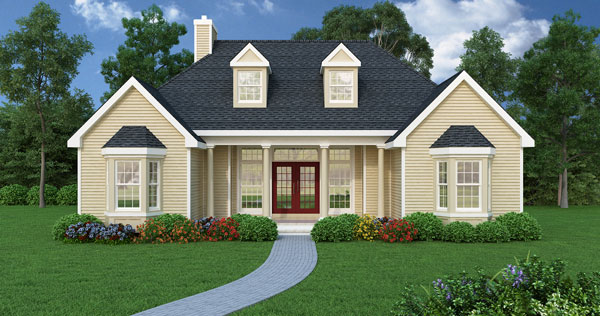It’s no secret that small houses are the current trend. Perhaps you’ve seen the plethora of news articles about families downsizing into homes small enough to be built on flatbeds and hauled by pickup trucks, or maybe you’ve watched the construction of such houses yourself, as the phenomenon has spread to television. Even people who don’t push it to the extreme by building downright tiny homes are seeing the benefit in purchasing smaller properties over larger ones. While the exact reasons for each homebuyer’s decision are different, there are a number of common factors involved in this cultural shift toward the less is more mentality.
This affordable ranch house plan is one of The House Designers’ best-selling small homes. This 1,389 s.f. home features a bonus space above and walkout basement for future expansion. A U-shaped kitchen, see below, takes advantage of all available wall space.
Financial Reasons
After the housing bubble burst and a credit crisis sent the United States into a recession, people were unable—or unwilling—to make such large purchases anymore. Between foreclosure, living paycheck to paycheck, and the overwhelming uncertainty of the market, it’s no wonder that consumers backed off and reevaluated their expenditure.
Just because conventional wisdom tells us that we should spend 28% of our net monthly income on the mortgage doesn’t mean we are bound to that guideline. A huge financial burden is relieved when people can choose to save and spend on things other than housing, and that peace of mind is a major part of why this trend toward smaller houses continues even as the economy improves. The U.S. housing bubble collapse was a wake-up call for many, and more people are making absolutely sure that they are only buying as much house as they want and can afford.
Being Green
Being environmentally conscious is a growing concern. Between the financial and ecological costs of living in a larger space, there is plenty to carefully consider before making a final decision. The eco-friendliness of a smaller house starts at construction and continues through the years, so it is definitely a good, rewarding investment. Starting with an ENERGY STAR/green house plan from The House Designers’ is a great way to ensure your home is energy-efficient.
A smaller house requires fewer materials to construct, including lumber, wiring, piping, insulation, etc. This translates to a reduced ecological footprint and less money taken out of your wallet. The benefits continue to stack up when you consider that heating a compact space requires much less energy. Every room will be closer to an exterior wall with a window, and since there will be less area for overhead and lamp lighting to need to cover, your electrical bill will also be trimmed down.
Age as a Factor
It should come as no surprise that a large number of young adults opting for smaller houses are driving this trend. Millennials are generally more conscious of their actions impacting the environment, and with fewer monetary resources than more seasoned professionals, a small home is a good way to move on from monthly rent and build credit and equity feasibly.
But what about the older generations? They certainly aren’t sitting out on this movement. Smaller homes are becoming popular for retirees because of the ease of upkeep and the reduced costs translating to less strain on their retirement funds. In addition to this, single-story homes remove the danger of falls down stairs, and the compact area means less difficulty getting around for those with mobility issues.
Small houses work for a broad range of personal circumstances, so their popularity is likely to continue growing as more baby boomers reach retirement and the younger millennials become interested in buying their first homes.
Simple Living
Bigger is not necessarily better. While large, grand houses have been traditionally seen as markers of success—and who doesn’t want that?—a more utilitarian mindset is becoming common. A big house requires a lot of upkeep, and that means money and time that people would rather allocate to other pursuits.
Somebody who doesn’t enjoy cleaning will rejoice that chores can be done quickly in a small house. Another person, who perhaps decides to invest heavily in art or music, will be glad that their money can go to those ventures rather than utilities. Those who have grown weary of materialistic, cluttered culture will be forced to choose which possessions they really want to keep, which will ultimately lead to a simpler, more meaningful existence.
All this is not to say that smaller homes are necessarily humble in design. Features like marble countertops, fine hardwood floors, and high-end appliances can all easily be incorporated into the space. For many, these amenities are more important than having a roomy floor plan, and the trade-off is well worth it.
The Resale Value Is Still There
It seems counterintuitive that a smaller house should necessarily be a good investment for the longer term, but as the demand for more economical, eco-friendly, and down-to-earth housing grows, there are plenty of buyers out there. While a mansion has a limited number of potential purchasers, there are swarms of people in the market for affordable options. If reselling is a real possibility—for instance, if you have to move often for your job—buying a smaller home is a good way to make your life easier in the future.
So don’t be fooled by their unassuming looks—smaller houses are a mighty force to be reckoned with as priorities and attitudes about housing change with the times.
- Transitional Home Design Is IN Right Now - September 9, 2022
- Texas Leads the Trends in Modern Farmhouses - August 19, 2022
- Finding Land to Build Your Dream Home - July 11, 2022


.jpg)
